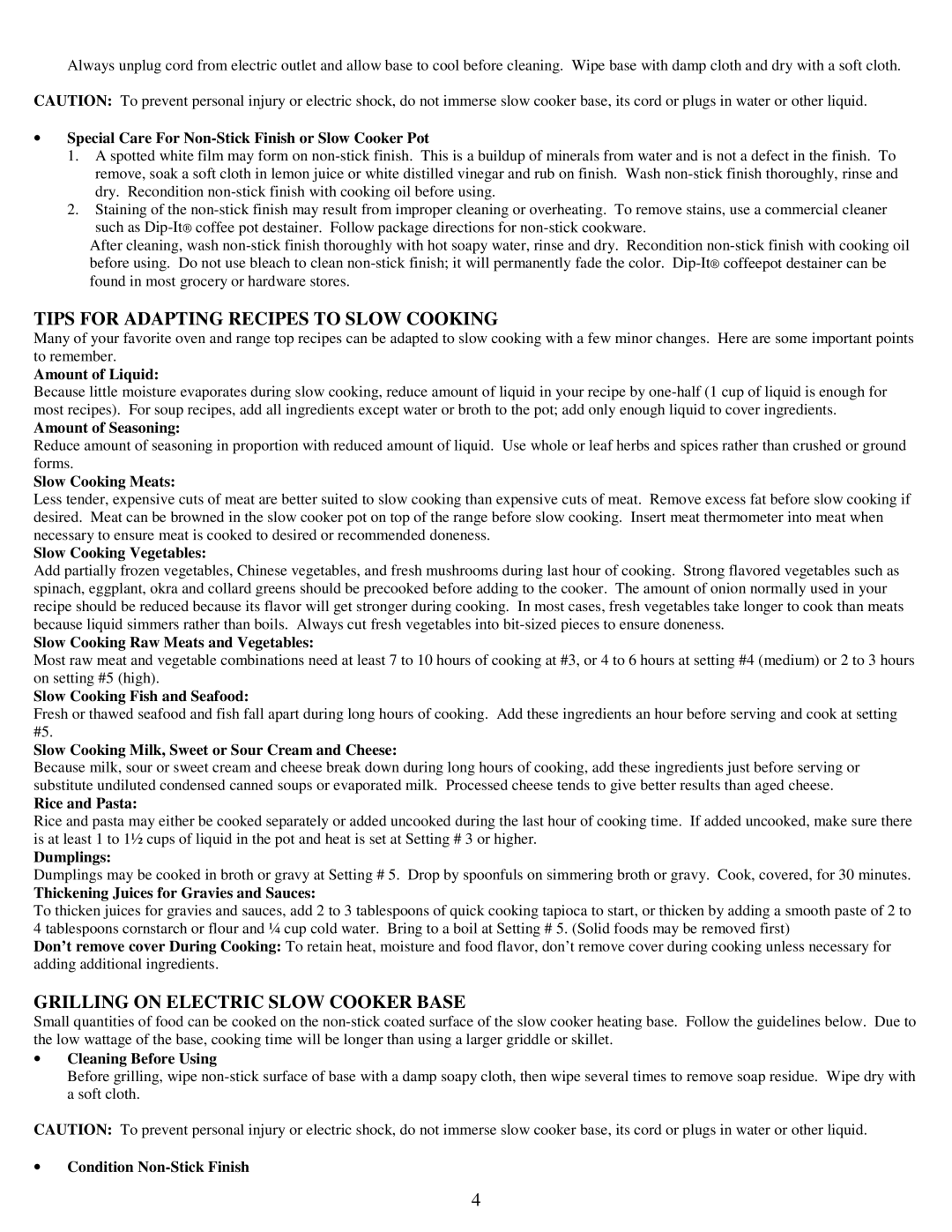Always unplug cord from electric outlet and allow base to cool before cleaning. Wipe base with damp cloth and dry with a soft cloth.
CAUTION: To prevent personal injury or electric shock, do not immerse slow cooker base, its cord or plugs in water or other liquid.
•Special Care For Non-Stick Finish or Slow Cooker Pot
1.A spotted white film may form on
2.Staining of the
After cleaning, wash
TIPS FOR ADAPTING RECIPES TO SLOW COOKING
Many of your favorite oven and range top recipes can be adapted to slow cooking with a few minor changes. Here are some important points to remember.
Amount of Liquid:
Because little moisture evaporates during slow cooking, reduce amount of liquid in your recipe by
Amount of Seasoning:
Reduce amount of seasoning in proportion with reduced amount of liquid. Use whole or leaf herbs and spices rather than crushed or ground forms.
Slow Cooking Meats:
Less tender, expensive cuts of meat are better suited to slow cooking than expensive cuts of meat. Remove excess fat before slow cooking if desired. Meat can be browned in the slow cooker pot on top of the range before slow cooking. Insert meat thermometer into meat when necessary to ensure meat is cooked to desired or recommended doneness.
Slow Cooking Vegetables:
Add partially frozen vegetables, Chinese vegetables, and fresh mushrooms during last hour of cooking. Strong flavored vegetables such as spinach, eggplant, okra and collard greens should be precooked before adding to the cooker. The amount of onion normally used in your recipe should be reduced because its flavor will get stronger during cooking. In most cases, fresh vegetables take longer to cook than meats because liquid simmers rather than boils. Always cut fresh vegetables into
Slow Cooking Raw Meats and Vegetables:
Most raw meat and vegetable combinations need at least 7 to 10 hours of cooking at #3, or 4 to 6 hours at setting #4 (medium) or 2 to 3 hours on setting #5 (high).
Slow Cooking Fish and Seafood:
Fresh or thawed seafood and fish fall apart during long hours of cooking. Add these ingredients an hour before serving and cook at setting #5.
Slow Cooking Milk, Sweet or Sour Cream and Cheese:
Because milk, sour or sweet cream and cheese break down during long hours of cooking, add these ingredients just before serving or substitute undiluted condensed canned soups or evaporated milk. Processed cheese tends to give better results than aged cheese.
Rice and Pasta:
Rice and pasta may either be cooked separately or added uncooked during the last hour of cooking time. If added uncooked, make sure there is at least 1 to 1½ cups of liquid in the pot and heat is set at Setting # 3 or higher.
Dumplings:
Dumplings may be cooked in broth or gravy at Setting # 5. Drop by spoonfuls on simmering broth or gravy. Cook, covered, for 30 minutes.
Thickening Juices for Gravies and Sauces:
To thicken juices for gravies and sauces, add 2 to 3 tablespoons of quick cooking tapioca to start, or thicken by adding a smooth paste of 2 to 4 tablespoons cornstarch or flour and ¼ cup cold water. Bring to a boil at Setting # 5. (Solid foods may be removed first)
Don’t remove cover During Cooking: To retain heat, moisture and food flavor, don’t remove cover during cooking unless necessary for adding additional ingredients.
GRILLING ON ELECTRIC SLOW COOKER BASE
Small quantities of food can be cooked on the
•Cleaning Before Using
Before grilling, wipe
CAUTION: To prevent personal injury or electric shock, do not immerse slow cooker base, its cord or plugs in water or other liquid.
•Condition Non-Stick Finish
4
